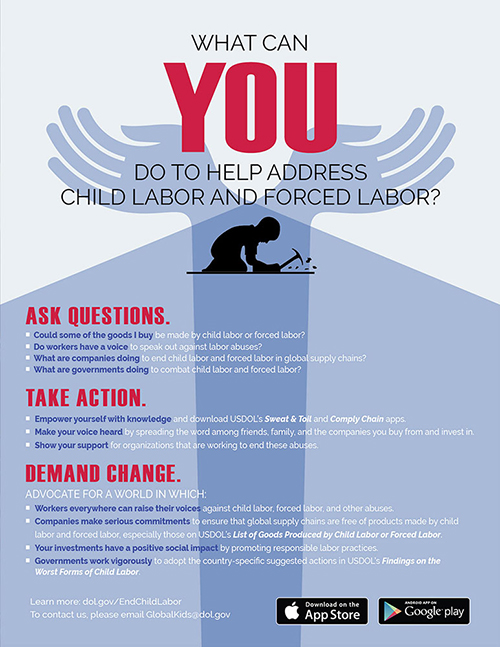List of Goods Produced by Child Labor or Forced Labor
The Bureau of International Labor Affairs (ILAB) maintains a list of goods and their source countries which it has reason to believe are produced by child labor or forced labor in violation of international standards, as required under the Trafficking Victims Protection Reauthorization Act (TVPRA) of 2005 and subsequent reauthorizations. The List of Goods Produced by Child Labor or Forced Labor comprises 159 goods from 78 countries and areas, as of September 28, 2022.
ILAB maintains the List primarily to raise public awareness about forced labor and child labor around the world and to promote efforts to combat them; it is not intended to be punitive, but rather to serve as a catalyst for more strategic and focused coordination and collaboration among those working to address these problems.
Publication of the List has resulted in new opportunities for ILAB to engage with foreign governments to combat forced labor and child labor. It is also a valuable resource for researchers, advocacy organizations and companies wishing to carry out risk assessments and engage in due diligence on labor rights in their supply chains.
The countries on the List span every region of the world. The most common agricultural goods listed are sugarcane, cotton, coffee, tobacco, cattle, rice, and fish. In the manufacturing sector, bricks, garments, textiles, footwear, carpets, and fireworks appear most frequently. In mined or quarried goods, gold, coal and diamonds are most common.
ILAB published the initial TVPRA List in 2009 and updated it annually through 2014, following a set of procedural guidelines that were the product of an intensive public consultation process. ILAB now updates and publishes the List every other year, pursuant to changes in the law.
Procedural Guidelines
On January 25, 2024, ILAB's Office of Child Labor, Forced Labor, and Human Trafficking published Procedural Guidelines for the development and maintenance of the List of Goods from countries produced by child labor or forced labor in violation of international standards.
| Country/Area | Good Sort ascending | Exploitation Type |
|---|---|---|
| Uganda | Child Labor | |
| Vietnam | There is evidence that children ages 5 to 17 grow sugarcane in Vietnam. The results of the Government of Vietnam’s National Child Labor Survey 2012, published in 2014, show that an estimated 28,303 child laborers are involved in growing sugarcane. Approximately 32.6 percent, or 9,227 of these child laborers are under 15 years old, which is the minimum age for employment in Vietnam. Of the estimated 28,303 child laborers who grow sugarcane, 3.9 percent are 5-11 years old, 28.7 percent are 12-14 years old, and 67.4 percent are 15-17 years old. The survey considers a child to be engaged in child labor if the child is working an excessive number of hours per week for his or her age, or if the child is engaged in work that is prohibited for underage employees according to national legislation. |
Child Labor |
| Zimbabwe | There are reports that children as young as age 9 produce sugarcane in Zimbabwe. Multiple local media reports identify cases of children working on sugarcane farms, particularly on outgrower farms in Masvingo Province, which is the main area for sugarcane cultivation in Zimbabwe. One source estimates that there are as many as 10,000 children working in the sector. Children working on farms producing sugarcane perform tasks related to irrigation, the cutting of sugarcane, and guarding crops. Children perform work at night and engage in hazardous activities, such as using machetes and chasing away wild animals. Many child laborers working in sugarcane production do not attend school because of their work. |
Child Labor |
| Turkey (Türkiye) | Child Labor | |
| Argentina | Child Labor | |
| Nicaragua | Child Labor | |
| Egypt | Child Labor | |
| Paraguay | Child Labor | |
| India | There are reports that children in India are forced to quarry stones. These children work in stone quarries, mines, and crushers under conditions of bonded labor. According to an assessment by the ILO, as many as 500,000 stone quarry workers, including entire families, in Tamil Nadu were bonded laborers. Families receive an advance payment and become bonded for generations to pay off the debt. Some children are used as a guarantee for the loan and are forced to work to pay it off. Some children inherit the debt of their parents and may be bought and sold between contractors. Children of scheduled castes, a socially disadvantaged class in India, and migrant children, are particularly vulnerable. The children live at the worksite and face isolation and restrictions on their movement. Some children are forced to work under threat of financial penalties or physical violence, receive little pay, and are denied wages. |
Child Labor, Forced Labor |
| Madagascar | Child Labor |
your hand? Download ILAB's Sweat & Toil App today!
Are you a company looking to fight child labor and forced labor in supply
chains?





